Hamilton Lanphere Smith, 1819 - 1903
by Brian Stevenson
last updated November, 2021
Professor H.L. Smith had a considerable influence on the characterization of diatoms, publishing definitive books and papers on that topic. He also produced an extensive project that consisted of microscope slides of 750 different species of diatoms, along with descriptions of those specimens. In addition, Smith left behind an extensive collection of mounted and unmounted material. His preparations are occasionally encountered nowadays.
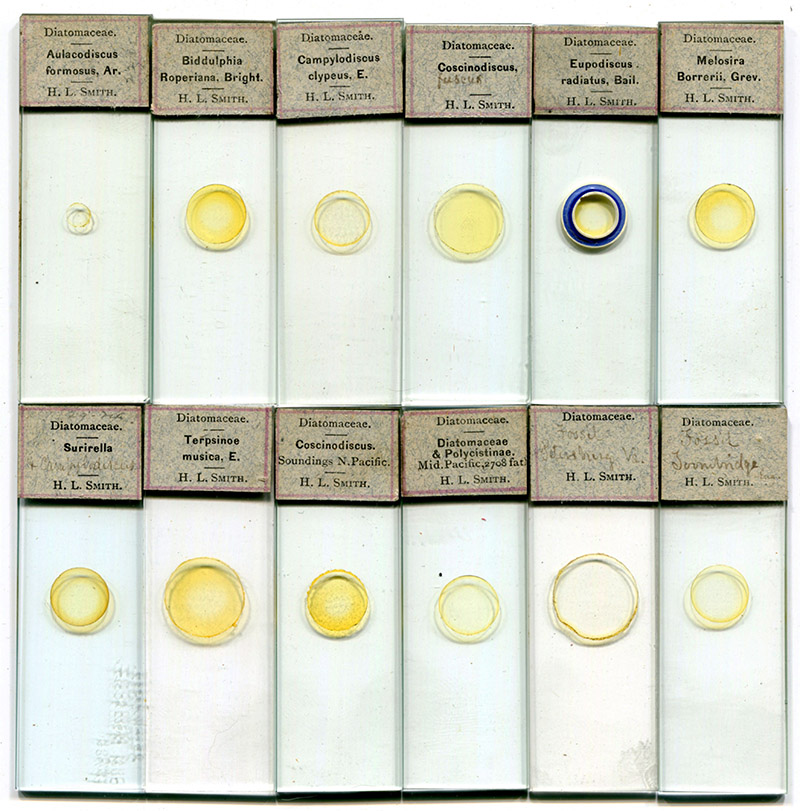
Figure 1.
Microscope slides by H.L. Smith. These may have come from his 1876-1888 series “Species Diatomacearum Typicae”, or from his personal collection, which was said to consist of several thousand slides. Some of the illustrated slides have handwritten descriptions of the specimens, and are not of diatom species, and are more likely to be from Smith’s personal cabinet. The slide on the lower left, of Surirella, is diamond engraved “fresh water, Tronhjem mud, Norway” – the handwriting appears to be different from the pencil writings on the slide label.
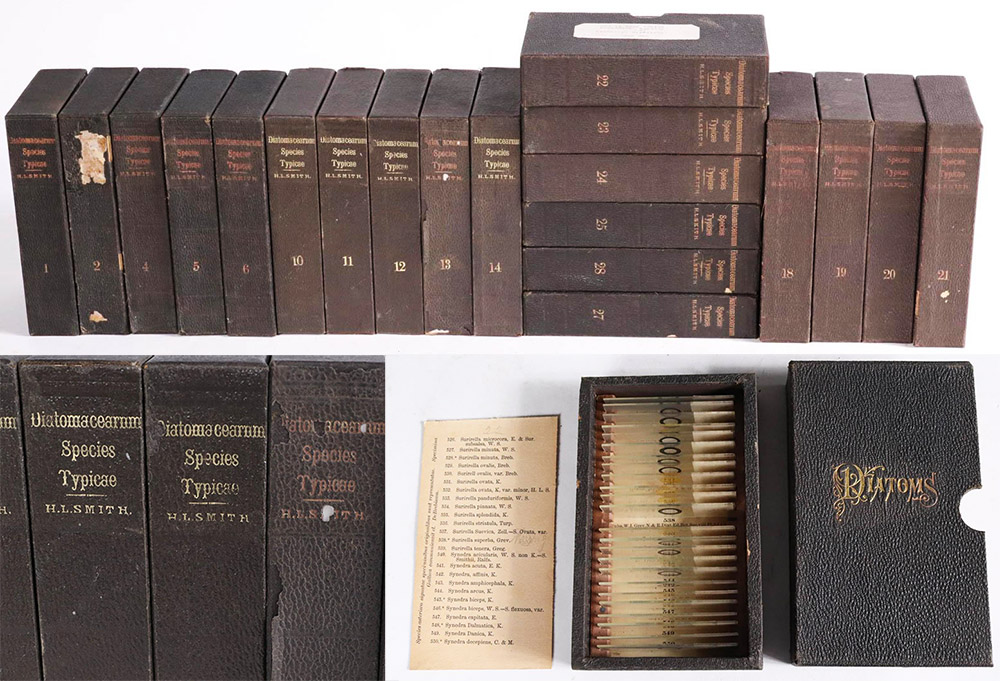
Figure 1B.
Twenty volumes of H.L. Smith's diatom slides. Each case holds 25 microscope slides, each with a different species. Adapted for nonprofit, educational purposes from an internet auction site.
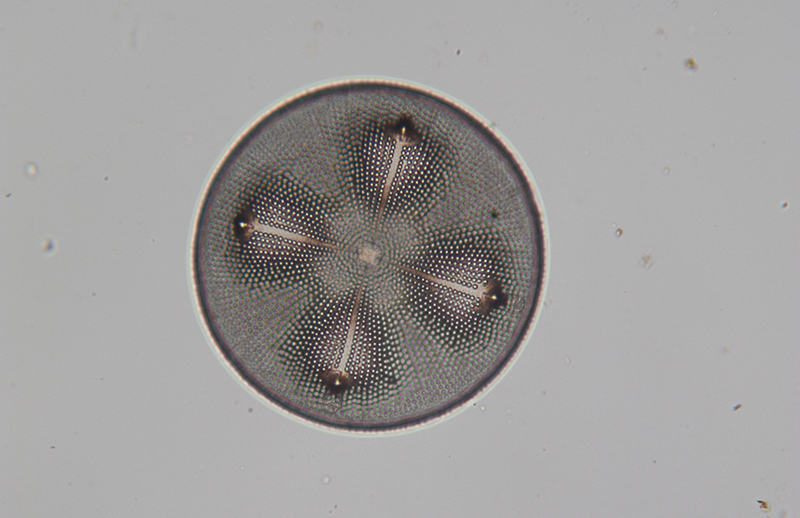

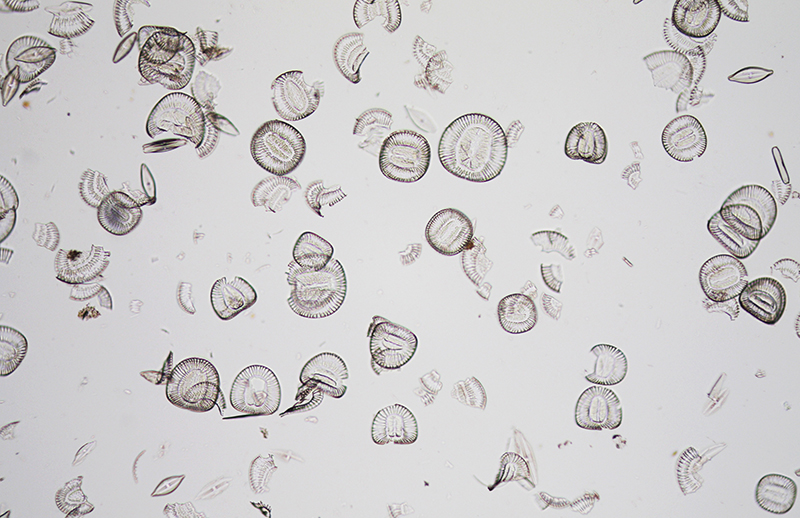
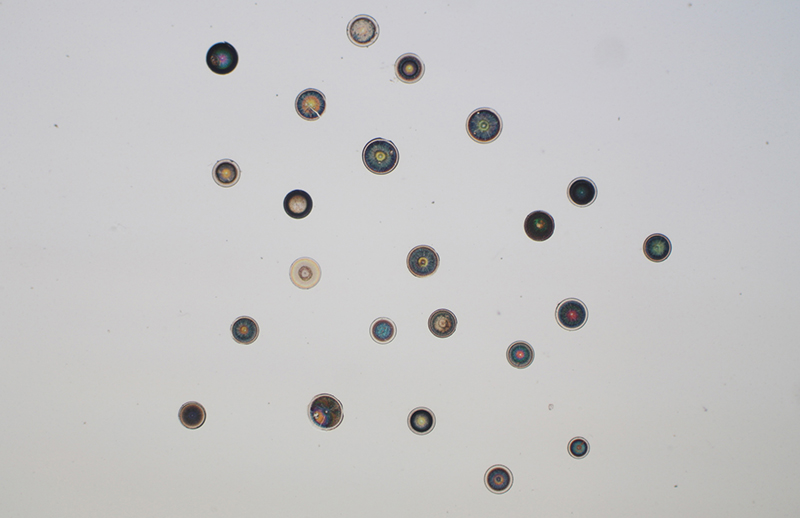

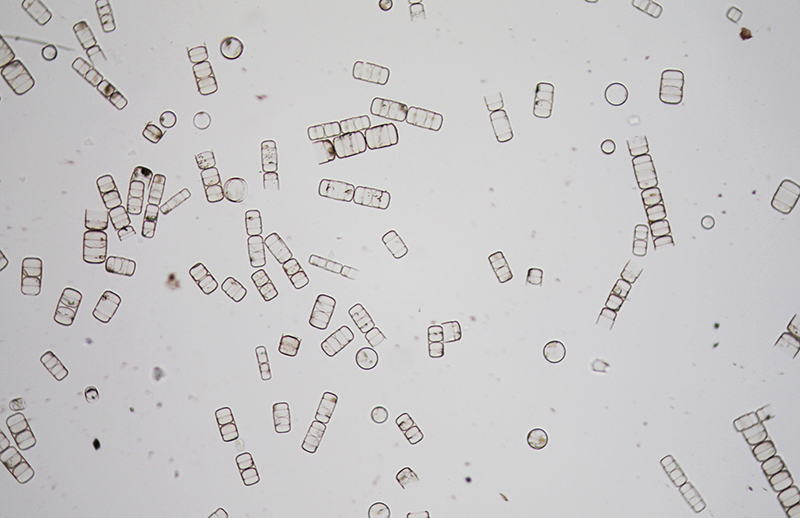
Figure 2.
Photomicrographs of the specimens in the top six slides of Figure 1. All photographed with a C-mounted digital SLR camera. The objective lens used for each image is noted. Top row: a single Aulacodiscus formosus, 25x; strew of Biddulphia roperiana 10x. Middle row: strew of Campylodiscus clypeus 10x; arrangement of Coscinodiscus fuscus 3.4x. Bottom row: arrangement of Eupodiscus radiatus 10x; strew of Melosira borrerii 10x.
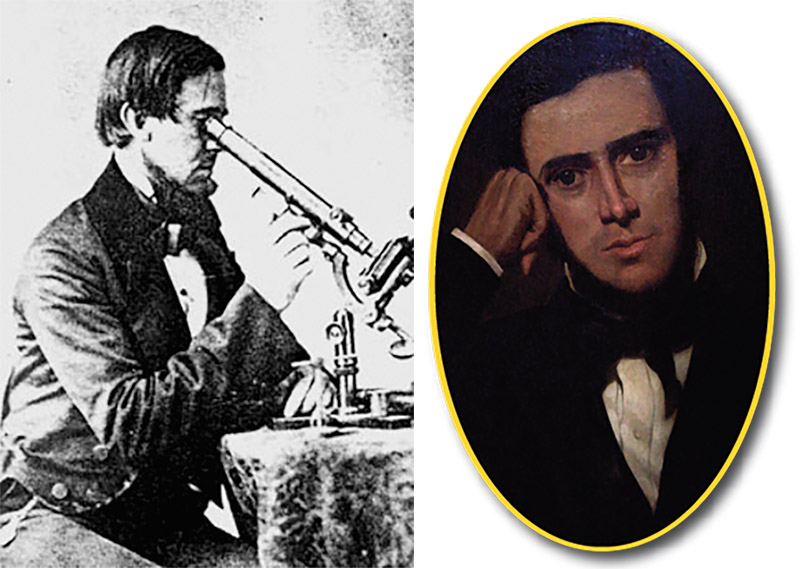
Figure 3.
Hamilton L. Smith as a young man.
Hamilton Smith was born in New London, Connecticut, USA, on November 5, 1819. He was the first child of Anson and Amy Crocker Beckwith Smith.
At the age of sixteen, he enrolled in Yale College, New Haven, Connecticut. Owing to Hamilton’s strong interest in the sciences, his father presented him with a professionally-built telescope when he began college. At Yale, Smith became close friends with another student, Ebenezer Porter Mason (1819 - 1840), likewise an astronomy enthusiast. Professor Denison Olmsted wrote of the pair and their works in 1838, “I was prevented, by peculiar circumstances, from making any preparations for viewing the interesting eclipse of September 18th, having returned home from a journey only on the day of its occurrence. I found, however, that there was less reason for regret, as two young gentlemen of our senior class, H.L. Smith and E.P. Mason, had been very assiduous in making preparations for viewing the eclipse, having the necessary instruments all in readiness, and the time well regulated. Indeed, each of them was furnished with a good telescope of his own making, the former a Gregorian of three feet focus, the latter a Newtonian of seven feet. Both accompanied me in the College Observatory, while I made use of our large Achromatic of ten feet focus”. Olmsted further wrote that “Messrs. H.L. Smith and F. Bradley have recently constructed a large telescope, of which they have furnished me the following memorandum: The reflector has a focal length of about fourteen feet and is one foot in diameter, of the Herschelian construction. The stand and adjustments are not yet completed, nor is the telescope in an advantageous position for making delicate observations. The tube is a twelve-sided prism, strengthened internally by iron rings”. For many years, Smith’s telescope was the largest in the United States. By use of this large instrument, Mason observed and described numerous nebulae, which became a seminal publication on astronomy.
Meanwhile, Smith’s family had moved to Cleveland, Ohio. His father’s business misfortunes required that Hamilton withdraw from Yale, and go to the family. Smith kept up his studies after business hours. He was able to return to the Yale campus for his senior year, and graduated with his class in 1839. During that year, he was elected a member of the Connecticut Academy of Arts and Sciences.
After graduation, Smith returned to Cleveland, to help with his father’s flour business. In 1841, he married Susan Beecher. However, she died within a year, after giving birth to the couple's daughter. Five years later, he married Julia Buttles, and the couple had two sons.
Smith’s interest in the sciences continued despite his business and family obligations. He published two of the first American textbooks on science, A Natural Philosophy for Schools, in 1842, and The World: First Lessons in Science and Astronomy, in 1845. He served as editor of the journal Annals of Science from 1842 to 1844, and frequently published in that and other journals.
In 1853, Smith left business in Cleveland to become Professor of Natural Philosophy and Astronomy at Kenyon College, in Gambier, Ohio. A newspaper of that year reported, “Prof. S. is extensively known among scientific men, both of Europe and America, as the able Editor of the Annals of Science, and associated with the lamented Ebenezer P. Mason as his intimate friend and constant companion in his astronomical pursuits. It was with the aid of Prof. H.L. Smith's ‘Great Telescope’, of 12 inch aperture and a focal length of 14 feet, that he was enabled, with Prof. Smith, to make in 1838-39, those nice observations on the Nebulae. This instrument of Prof. H.L. Smith's was at that time the largest in America, and was made at Yale College, by his personal skill and labors. An account of its performances may be seen on the 174th page of the 35th volume of Silliman's Journal. Prof. Smith is now engaged in constructing another Telescope, and like his former instrument, it will be the largest reflecting one in America, having an aperture of 20 inches, and a focal length of 20 feet. He has succeeded in casting the speculum, and it is annealed. The other parts are in process of completion. The Work progresses”.
Smith developed an interest in the new field of photography during his college years, and wrote on the daguerreotype method in 1841. Adolphe-Alexandre Martin (1824-1886) proposed in 1853 to use the collodion process to produce a direct positive image on black-varnished metal plates. Smith pursued that idea, and in 1856 patented a method to produce positive photographs on thin sheets of iron (the iron was “japanned”, meaning coated with glossy black varnish) (Figure 4). He is, therefore, generally recognized as the inventor of the “tintype” photograph (also known as “melainotype” or “ferrotype”). Smith sold the patent to his student and assistant, Peter Neff, who then marketed the process and collected royalties.
Smith’s tintype patent was disputed by Victor Griswold (1819-1872), who had also received a patent for a similar process at the same time. The patent disagreement was eventually resolved, but competition between Neff and Griswold drove down prices. Tintypes became very popular, as they were inexpensive to make and to buy (Figure 5).
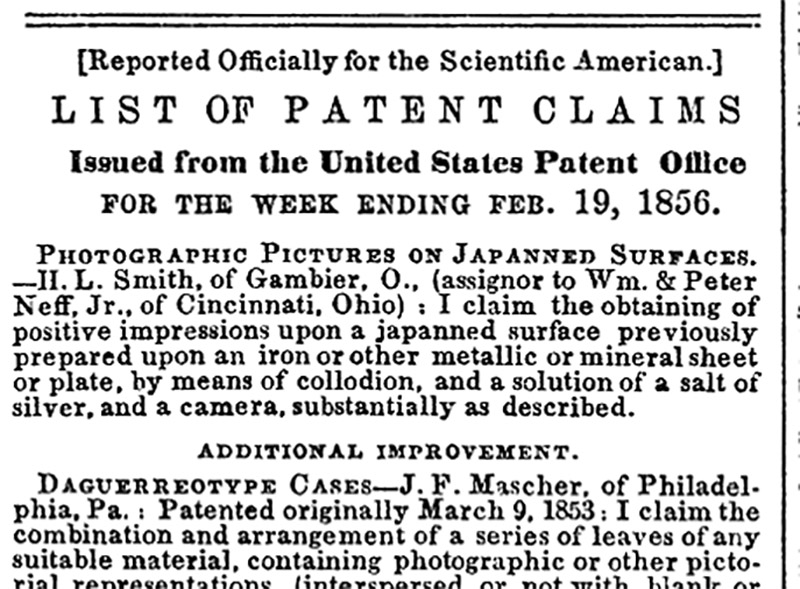
Figure 4.
Announcement of H.L. Smith’s 1856 patent for “tintype” photography.

Figure 5.
Front and rear views of tintype photographs, made by Smith’s method. The paper-framed photograph is the size of a carte-de-visite (CDV) photograph, about 4 x 2.5 inches (10 x 6 cm).
In 1868, Smith left Kenyon College to join the faculty of Hobart College in Geneva, New York, where he was appointed the Prendergast Professor of Astronomy and Natural Philosophy. According to Smith’s biography on the Hobart College web site, “he was one of five professors who ‘formed a distinguished faculty which made Hobart College respected through all the vicissitudes’ of the late 19th Century and was known as a confidant and benefactor of students and younger faculty”. Smith served as acting president of Hobart from 1883 to 1884.
In addition to his interests in astronomy, Smith developed expertise in microscopic examinations, especially diatoms.
In 1872, he published part one of what would become a three-part series entitled Conspectus of the Families and Genera of the Diatomaceae. He arranged diatoms into three tribes, consisting of 15 families and 110 genera. Smith’s method was adopted by many other diatomists, including Henri Ferdinand Van Heurck.
Smith produced another significant contribution to the understanding of diatoms in 1874, with the release of the first issue of Species Diatomacearum Typicae. This was a collection of diatom preparations on microscope slides, accompanied by their descriptions. Smith issued further volumes through 1888, with each issue consisting of 100 or so slides, reaching a total of 750 different species. These extensive collections were made possible by Smith's exchange of specimens with microscopists from around the globe.
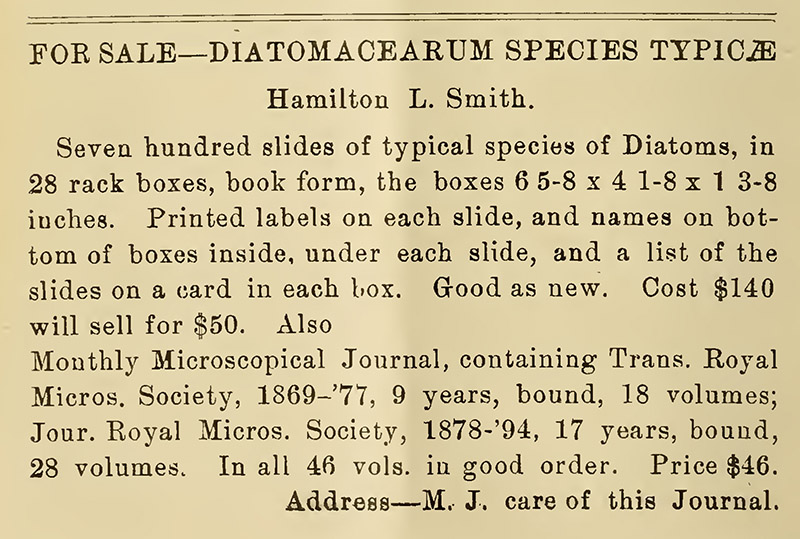
Figure 6.
�An advertisement from 1898, describing the form of H.L. Smith’s “Species Diatomacearum Typicae”.
Along with A. Mead Edwards and Christopher Johnston, Smith published Practical Directions for Collecting, Preserving, Transporting, Preparing and Mounting Diatoms in 1877. Smith’s description of his mounting methods, On the Preparation of Diatomaceae, is reprinted at the end of this essay.
According to Kiser, Smith’s “private collection of several thousands of diatom slides, 4,000 bottles of cleaned diatoms, and extensive collection of diatomaceous earths was the largest in the United States, as was his personal library of microscopical literature, which contained marginalia and letters and drawings from other diatomists. Both the collection and the library were purchased by Dr Edward Francis Hodges of Indianapolis in 1893 … (later) the H.L. Smith slide collection and library began a final series of moves which severed the slide collection into parts and ultimately resulted in the dispersal and loss of the majority of the books, along with Smith's irreplaceable notations and the scientific correspondence of a lifetime”.
During his life, Smith served as President of the American Microscopical Society, and was a member of the Connecticut Academy of Sciences, the Lyceum of Natural History of New York (later the New York Academy of Sciences), the Boston Society of Natural History, the Microscopical Society of Edinburgh, the Quekett Microscopical Club, the Belgian Microscopical Society, and the Royal Microscopical Society.
Smith retired from his professorship at Hobart College in 1900. He died on August 1, 1903, at New London, Connecticut, “from the effects of a fall received about two weeks previously”. Smith was then 85 years old. His wife, Julia, had died in 1891. All three of his children also preceded him in death.
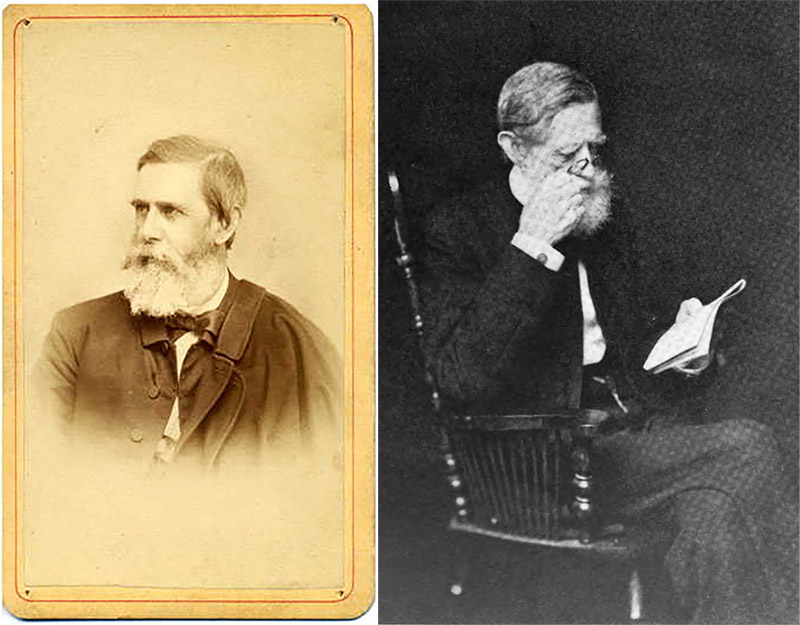
Figure 7.
Left, an undated carte-de-visite photograph of H.L. Smith, adapted from http://person.ancestry.com/tree/86731620/person/30542993955/facts. Right, a photograph of Smith from Hobart College’s 1889 edition of “Echo of the Seneca”.
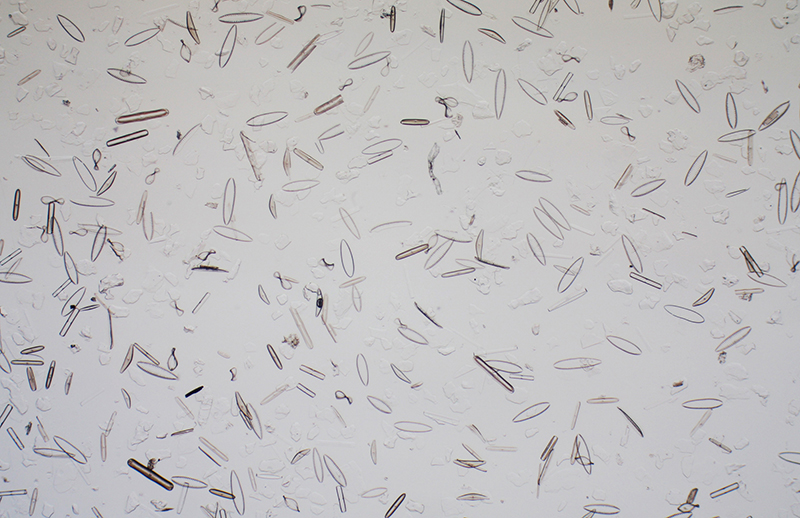
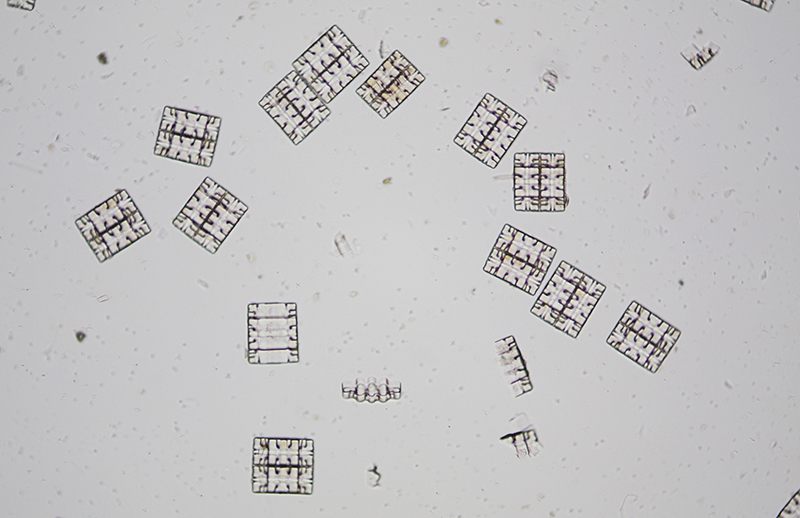
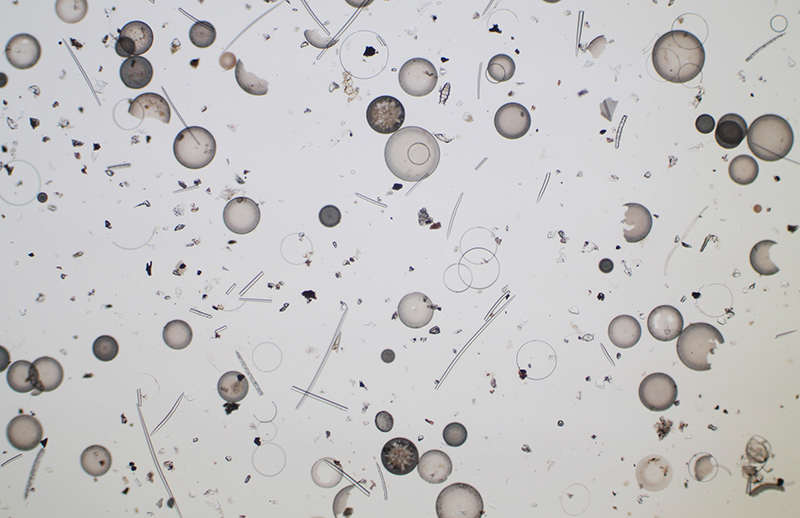
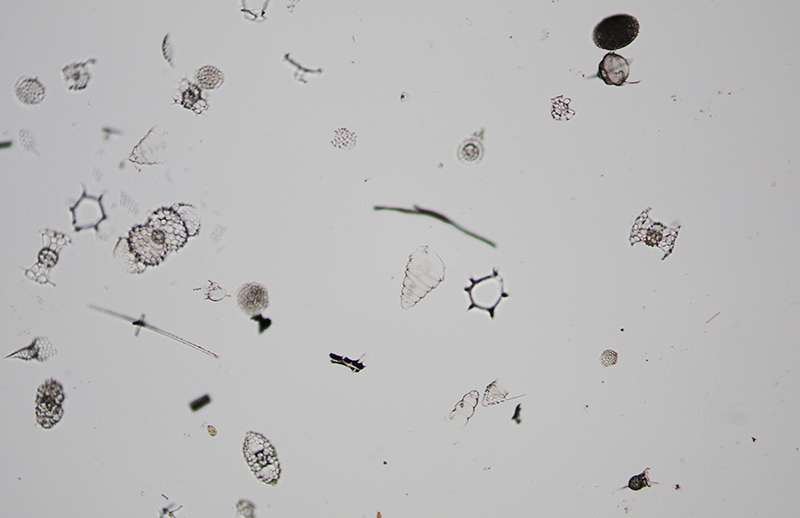
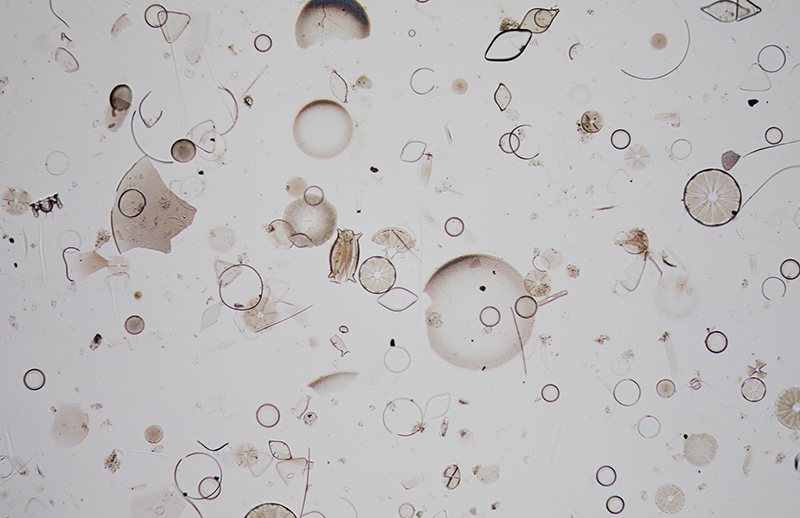

Figure 8.
Photomicrographs of the specimens in the lower six slides of Figure 1. All photographed with a C-mounted digital SLR camera. The objective lens used for each image is noted. Top row: strew of Surirella and Campylodiscus spp., 3.4x; strew of Terpsinoe musica, 10x; Middle row: mixed strew containing Coscinodiscus, from North Pacific soundings, 3.4x; mixed strew of diatomaceae and polycystina from a dredging of 2708 fathoms from the Mid-Pacific, 10x. Bottom row: strew of fossil diatoms from Petersburg, Virginia, 10x; strew of fossil diatoms from Fossil Toome Bridge, Ireland, 10x.
On the preparation of Diatomaceae, by H.L. Smith, from Edwards, Johnston, and Smith’s 1877 Practical Directions for Collecting, Preserving, Transporting, Preparing and Mounting Diatoms:
“What I have to say relates to the rapid preparation, from crude material, where this has been at all carefully gathered, and to a mode of mounting, invariably on the cover of the slide, but which has some great advantages. The gatherings should not be dried, but kept moist, in phials, with a little creosote to prevent mould. I very much prefer to examine whole frustules, with both valves adherent, or if filamentous, still cohering. And I have many bottles of preparations for mounting which are nearly as clean as though they had been treated with acids. And many of the most interesting preparations which I have were never boiled in acids. Of course, very much depends upon the skill and carefulness of the gatherer, and a little patience and judgment will enable any one to obtain the crude material tolerably pure. Only a few days ago I made a gathering of Nitzschiae, in which I have the frustules almost as free from foreign matter as though they had passed through the most elaborate acid and chlorate of potassa treatment.
Supposing, then, that one has before him a phial which will hold a considerable quantity of water compared with the sediment in it, the latter composed more or less of diatoms. We proceed thus, and if it has stood for some time perfectly undisturbed so much the better. The bottle is twirled rapidly, and the lighter material rising up in the axis will soon diffuse itself throughout the water. Allowing it to settle for two or three seconds, until to the eye the grosser portions have just been deposited, all that remains floating is now poured off into another phial, and it is from this stock that we are to separate the diatoms and sand from the clay and organic matter. The material poured into this second bottle is allowed to settle until the water simply appears milky or cloudy; the time will vary according to the minuteness of the diatoms, and can only be judged of from experience, say one minute, when all that remains floating must be poured off, and thrown away, unless there are very minute forms which it may be desirable to separate. The phial is again to be filled with rain, or distilled water (hard or lime water should be strictly eschewed), and again shaken up. As soon as the heaviest deposit touches bottom, the rest should be poured off into a third phial, leaving say about one-fourth the amount behind in the second phial. This third phial will now consist mainly of sand and diatoms, with lighter organic matter and pure clay; the last two can be removed by elutriation; for this purpose, fill the phial No. 3 with water, and after well shaking allow it to settle two to five minutes, pour off and throw away the slightly milky water, and repeat the operation, allowing it to settle a somewhat longer time; the operation may be repeated a third time, when particles, suspended after an interval of eight or ten minutes, may be poured off. Often, after the first settling of bottle No. 2, the diatoms will rise more pure in the mass by twirling the bottle than by shaking it up. A little practice and care will enable any one to separate certain diatoms according to size. I had a gathering of Pleurosigma Spencerii from Scioto River, O., sent to me, but although it had been chlorated, still, when a mounting was made, not more than one or two frustules would be in the field of view, the great mass being either smaller forms, or fine fragments of silex; by careful watching and testing the time when the different sizes would remain suspended, I have made from this a preparation, which will show hundreds where before were scarcely any, and which would never be recognized as the same gathering. Supposing now a trial shows us the diatoms tolerably abundant, the trial being made by heating in the manner presently to be described; the phial is filled with alcohol and water, half and half. Some samples of alcohol leave behind a scum after evaporation, especially noticeable after burning in the mode presently to be described, and water which will leave crystals, or any scum, must be avoided; the beauty of the preparation will largely depend upon being particular in this matter.
For mounting diatoms I invariably place a drop of the fluid containing them upon the cover, never on the slide. The alcohol and water will spread out on the slide, but will remain heaped up on the round cover, like a plane convex lens. I prepare a little stand, represented in the accompanying wood cut, of quite fine wire (so as not to conduct off too much heat) bent at right angles and inserted into a base; the free end is bent into a ring, and upon this ring is placed a square plate of very thin iron, (such as is used for the so-called ‘tintypes’ in photography, with the Japan burned off,) held in place by bending the corners of the square over the ring, loosely, to allow expansion, without bending when heated; upon this plate the cleaned cover is placed, and then, by means of a pipette, a drop of the alcoholic liquid with the diatoms is placed upon it, and the spirit lamp applied below. The alcohol takes fire and is allowed to burn out; the flame of the lamp is then placed beneath, and the rest gently boiled, the remaining alcohol escaping during this ebullition causes the diatoms, by this very act, to distribute themselves very evenly over the cover, and all matting is effectually prevented. It is better after one perceives that this even distribution has taken place, not to push the heat so as to make large bubbles again, but to slowly evaporate until dry, after which the full power of the flame must be applied until the iron plate and the glass cover is red hot; at first the mass of diatoms, etc., will become black, but as the organic contents and debris burn away there will finally remain only the silex nearly white. I invariably burn in this manner on the cover even the specimens which have been prepared with acids, for the diatoms thus treated when mounted appear much sharper and cleaner. The amount of heat, if the diatoms are rigidly siliceous, as most of them are, may be the full power of an ordinary alcohol flame continued for some time, but if they are imperfectly siliceous, care must be exercised in the burning.
I invariably use old balsam for mounting, just as bought from the shops, especially if I wish to have a specimen which will bear immediate handling, or be ready to be sent off soon as mounted. Allowing then the cover to cool, while the slide is being cleaned to receive it, I place a drop of the balsam, which must not be fluid, only viscous, on the middle of the slide, and now with this pick up the cover from the little stand where it has been heated. The diatoms will be so fastened by the heating, that but few will flow out from under the cover, if any, in the subsequent treatment. I now hold the slide over the flame of the lamp (which should be much smaller than when used for the burning) until not only all under the cover is a mass of small bubbles, but until very large bubbles, balsam steam, appear; the flame is removed soon as the bubbles are observed all running to one edge. I press down the cover at this place by a mounted pin, and start them in the opposite direction. This may seem unnecessary, but long experience shows that this is the better way to get rid of them; during this the slide is held somewhat obliquely, the cover is kept from slipping by the pin, and if all the bubbles do not disappear, then with a very small flame heat is applied just beneath the obstinate ones, the slide being held slanting, and that part upwards where the bubbles are nearest the edge of the cover. The description is longer than the actual process, and the slide when cool is ready for immediate use. Perhaps I am wedded to old ways, but after trial of fluid balsams, without heat, I have always come back to the old way; still, for selected diatoms, some of these preparations of balsam are good. If the diatoms are to be mounted dry, always the best way, if for real study, I make a ring of the zinc white in balsam, (sold by the opticians,) and which in a moment or two is sufficiently hard to receive the cover, and never runs in; after standing an hour or two I give a finishing ring of same, or the usual black varnish on the outside.
I think any one who will adopt the mode of mounting on the cover, and subsequent heating, as above described, whatever may be the rest of the procedure, will never consent to give up this part, since it effects so even a distribution, and such destruction of residual organic matter, and gives such increased brilliancy to the preparations; sometimes, if the acid has not been thoroughly washed out of acid treated, specimens, snappy explosions will occur when the alcoholic mixture is heated; of course, the remedy is to pour off, and replace with pure water and alcohol”.
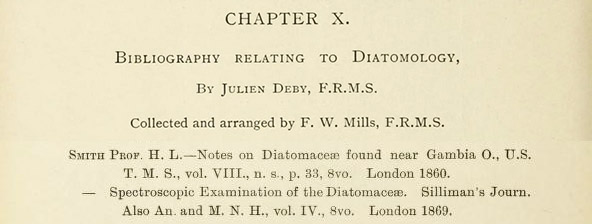
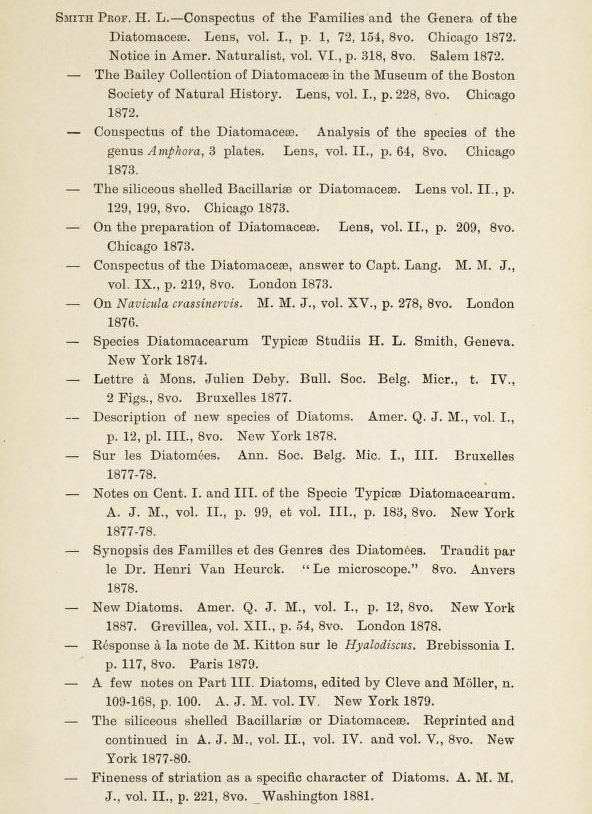
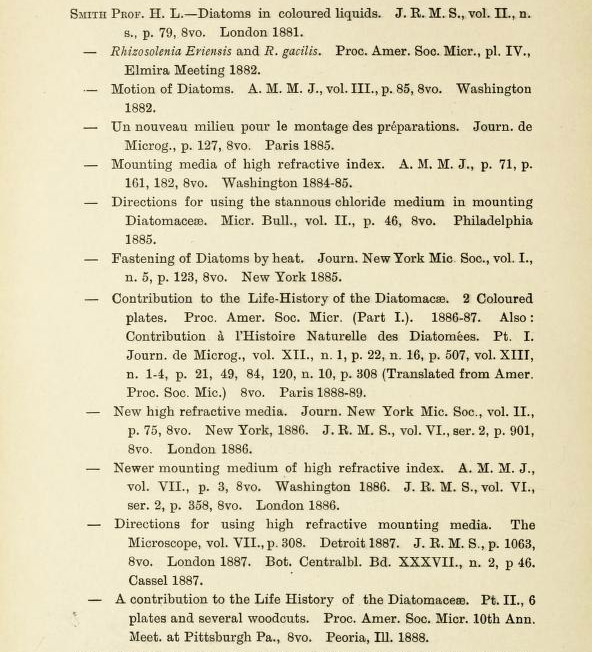
Figure 9.
Bibliography of H.L. Smith’s publications on diatoms, from Mills and Deby’s 1893 "An Introduction to the Study of the Diatomaceae".
Resources
The American Monthly Microscopical Journal (1898) Advertisement for sale of Smith’s Diatomacearum Species Typicae, Vol. 19, page 16
The Echo of the Seneca (1889) Dedication, Vol. 38
Edgar, R.K. (2008) Bibliography of Published Collections (Exsiccatae) & Their Institutional Locations, http://www2.huh.harvard.edu/diatom/publbibliogr.htm
Edwards, A. Mead, Christopher Johnston, and Hamilton L. Smith (1877) Practical Directions for Collecting, Preserving, Transporting, Preparing and Mounting Diatoms, Industrial Publication Co., New York
The Farmer’s Companion (1853) Note on H.L. Smith, Vol. 3, page 252
Historic Camera (accessed November, 2016) Smith’s tintype patent, http://www.historiccamera.com/cgi-bin/librarium/pm.cgi?action=display&login=neffpatent
Hobart and William Smith Colleges (accessed November, 2016) Hamilton Lanphere Smith, http://www.hws.edu/alumni/dfa/smith_hl.aspx
Kiser, Joy (accessed November, 2016) Hamilton L. Smith's Diatomacearum Species Typicae and his lost microscopical library, http://www.users.zetnet.co.uk/shnh/MTG_past_LSS_abs_K-M.html
Mason, E.P. (1840) Observations on nebulae with a fourteen feet reflector, made by H.L. Smith and E.P. Mason, during the year 1839, Transactions of the American Philosophical Society, Vol. 7, new series, pages 165-213
Mills, Frederick William, and Julien Deby (1893) bibliography includes a comprehensive publication record of H.L. Smith papers, An Introduction to the Study of the Diatomaceae, Ilife and Son, London
Obituary Record of Graduates of Yale University (1900-1910) Hamilton Lanphere Smith, pages 296-297
Olmsted, D. (1838) Observations made at Yale College on the eclipse of the Sun of September 18, 1838, The American Journal of Science and Arts, Vol. 35, pages 174-175
Schimmelman, Janice G. (2007) The Tintype in America 1856-1880, The American Philosophical Society
Science (1903) Notice of the death of H.L. Smith, Vol. 18, page 221
Smith, H.L. (1865) On a new growing slide for the microscope, The Annals and Magazine of Natural History, Vol. 13, series 3, pages 334-336
Smith, H.L. (1873) The Queen's Chamber in the Great Pyramid, The American Journal of Science, Vol. 6, Third series, pages 321-333
Steinicke, Wolfgang (2010) The short career of Ebenezer Porter Mason, in Observing and Cataloguing Nebulae and Star Clusters, Cambridge University Press, Cambridge, page 94
Waldack, Charles, and Peter Neff (1858) Treatise of Photography on Collodion, second edition, Longley Brothers, Cincinnati, Ohio





















